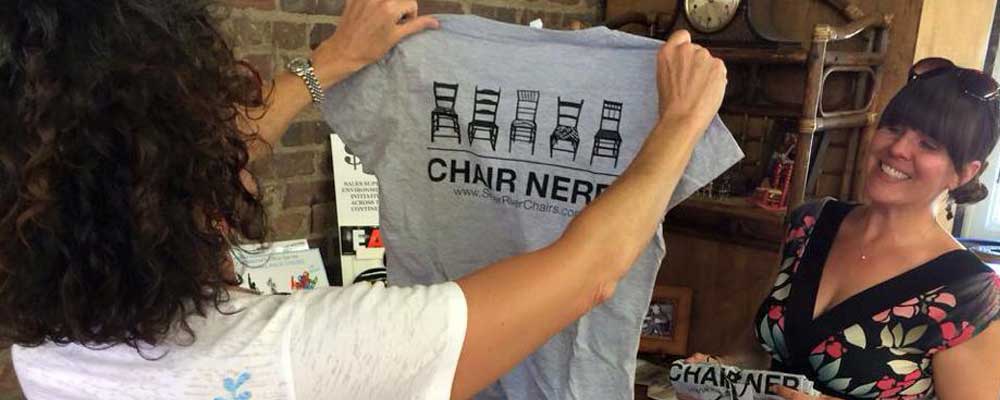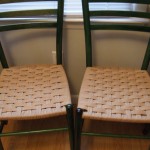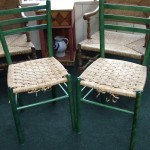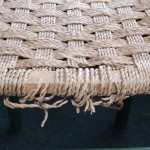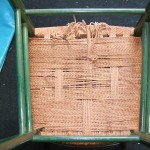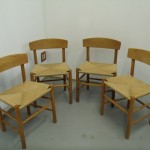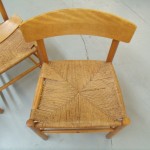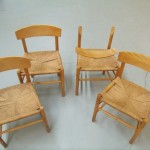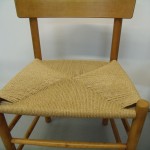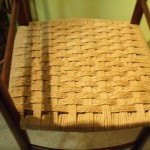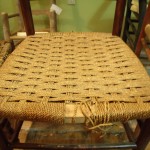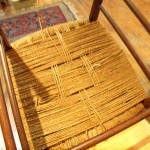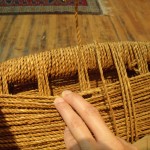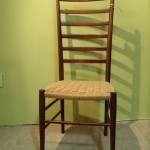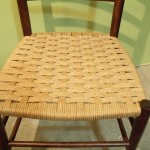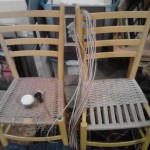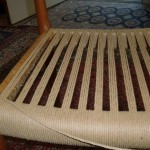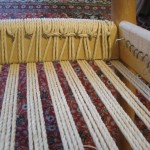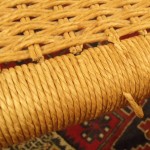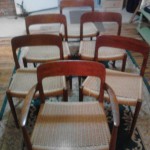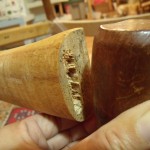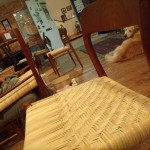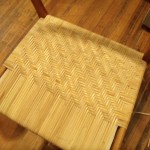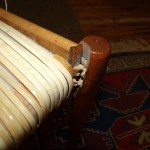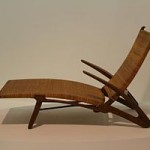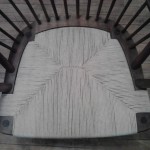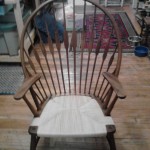Stolen….Mid-Century Modern Goodness
In Denmark, Stolen=Chair
(This post is long, scroll to the bottom if you just want to see lots of photos.)

Hans Wegner chair
The Danes excel in every design medium, from home decor to the Sydney Opera House, but my focus is obviously chairs. A few years ago I was humbled by Tom of Oddfellows as I commented on their increasing inventory of retro chairs, to which he replied, “it’s called Mid-Century, idiot.” (Tom did not call me an idiot.) Since then the Danish Chairs have been steadily rolling through the doors of Planet Art.
Although Danish Furniture Guilds have been operating for hundreds of years, the pinnacle of Danish design is the mid-20th Century. Clean, functional, simplistic, comfortable, warm, and classic are the most common descriptions of Danish style, but never boring.

Jacobsen's Egg Chair
A more organic branch of the Bauhaus Movement, it combined new industrial revolution techniques with high quality craftsmanship to create a harmonious balance between chair and sitter. They measured human form and created a gorgeous seat that curves and supports.

Arne Jacobsen's Ant Chair c. 1951
While most modern designs use metal, Danish design incorporates natural material including leather, cord, and cane. Often these stolens are made with teak or rosewood, but they have no simple rule of thumb, as seen with Arne Jacobsen’s Ant Chair and Egg Chair.
Most seen today in our studio are the classic Danish Modern chair by Neils Otto Moller, but Hans Wegner’s Peacock Chair & Wishbone Chair have made an appearance. The popularity of the design was such that it warranted center stage in a presidential debate.

Danish Modern Chair in the Kennedy Nixon debate
Woven Seats on Danish Modern Chairs:

Finishing and starting a strand is relatively simple. After weaving is completed, all nails will be hammered down
Danish Cord weaving most often employs a 3 ply steep twill whipcord woven in a single layer around L-shaped nails in the wide wooden frame of a chair. Essentially it is a fancy paper rush.
Its historic counterpart is twisted seagrass or rushes which is still available and used today, but is not as sturdy as Danish Cord. Some rails are too thin for so many nails requiring you to weave around the rails with a top layer and bottom layer (which should look as good as the top. (Don’t be a slacker!)
Sometimes binder cane is employed on Danish Chairs, and I hate to admit that it still looks good, because it is a pain in the arse to weave. We once repaired a set of these…and I have to tell the story: We hear it all the time that chair caning is a dying art. It literally was in this case. The man who was working on them died in the middle of the repair (may his soul, hands, and back rest in peace). After working on 8 of these chairs, we wanted to die too.
The main repair issue with Danish Cord Chairs

typical wear on Danish Cord chair...all the weight is on double strands spaced across the front and back rails
(and almost every other chair we see) is the cord or cane breaking along the sharp edge of the front rail. For all of the accolades about precision, design, and craftsmanship, they neglected to shave down the 90 degree angle where the sitter’s legs press the cord into the sharp wood, eventually causing the cord to break all along the front and back edges. There must be a conspiracy between seat weavers and chair makers, because this happens ALL THE TIME.
Got a broken Danish stolen with a woven seat?
We can fix it for you, or you can take a class. To fix a Danish Cord chair yourself, purchase The Caner’s Handbook by Jim Widess at our studio for $20.
Want to find some Mid-Century Modern goodness in Asheville?

Currently at Revive Asheville in Biltmore Village
Revive Asheville is a boutique shop in Biltmore Village specializing in exceptional 20th Century Modern Design. The owner, Chris Sabo, regularly posts his impressive furniture finds that are available for sale on their facebook page. He currently has a desk by Hans Wegner and several incredible pieces by local designers, one of which, a cabinet, is so beautiful and well constructed, it’s like seeing a famous painting by a Renaissance master….I almost cried.
While you’re in the neighborhood, stop by

currently at Oddfellows, a 12, 000 sq. ft. design center
Oddfellows Antiques to score something cool out of their ever expanding mid-century section. Check out their blog (it is great!) or their facebook page. They have recently expanded their Garden Room and have a new stained glass room. Oddfellows has an amazing collection of hand-picked European imports. In addition, they feature home decor, accessories, lighting, rugs and art. Their gallery photos speak volumes.
Of all the chairs I repair, I would fill my home with Danish modern chairs…if I could afford them. They retain a tremendous value, from $200-$10,000 (yes, that is per chair) as compared to the lovely French Cane chairs that can be more expensive to repair, but are often stashed in an attic for decades. Not these chairs…nobody puts a stolen in a corner!
- My first time weaving with Danish Cord
- Before image of my first Danish Cord project
- Typical wear on a sharp rail.
- Seriously?! The bottom has to look as good as the top.
- Nice work Dave!
- Typical wear on a rail (the person who last wove, did not stuff the seat for support!)
- Before shot of Rush pattern with Danish COrd
- That is a good lookin’ seat.
- If you have integrity as a weaver, this is what the bottom of your seat would look like.
- Typical wear on a rail
- Lazy weavers take short cuts on the bottom.
- You can see that most of the weight of the sitter rests on the 4 widely spaced strands.
- LOVELY INDEED.
- Too bad I don’t own this chair
- Soon available for sale on Planet Art!
- Top of chair…Warp and fill-ins complete, loose end tied, ready for weaving
- Bottom of chair….Warp and fill-ins complete, loose end tied, ready for weaving
- typical wear on Danish Cord chair…all the weight is on double strands spaced across the front and back rails
- set of Moller chairs
- Bummer! The mortise and tenon joint dry-rotted!
- Only 10 more hours on this chair! Every inch is a victory
- Splint weave on a Danish chair takes FOR-EV-ER!!!
- Got about 15 hours into the weaving and the joint broke!
- Hans Wegner chair
- Danish Modern Chair in the Kennedy Nixon debate
- Difficult to weave seat on a Wegner Peacock Chair
- Peacock Design by Hans Wegner we were fortunate to work on! Thanks Furniture Repair Works.
If you are a design/furniture freak, pick up the book Danish Chairs by Noritsugu Oda and visit the following websites:
http://denmark.dk/en/~/media/Denmark/Documents/Lifestyle/Furniture-Industrial-design-2008-en.pdf
http://www.dwr.com/category/designers/m-p/niels-otto-moller.do
http://www.danish-furniture.com/
The following sites listed are for the average curious visitor and internet time waster:
http://en.wikipedia.org/wiki/Hans_Wegner (in fact, just wikipedia “chairs” and see all kinds of crazy stolens)
http://www.eithni.com/Whipcordingdemo.htm (see a hippie chick’s photo journey of cord-making a la Danish cord)
http://www.acaneandwickerfixer.com/danish_cord_weaves.htm (these Oregonian repair folks have done it all!)
Share this article...
